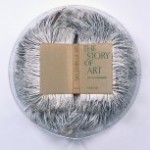Literary Constructs
10 November–2 December 2006
Six artists working with text, poetry and altered books: Chris Kenny, Vito Drago, Liliane Lijn, Rupert Spira, Arthur Giardelli and Georgia Russell.

10 November–2 December 2006
Six artists working with text, poetry and altered books: Chris Kenny, Vito Drago, Liliane Lijn, Rupert Spira, Arthur Giardelli and Georgia Russell.

5 October–4 November 2006
This retrospective view of Brisley’s work focuses primarily on his paintings with a selection of films of his performances, including the first screenings of The Leg and Sweating the Hole.

14–29 July 2006
Maliheh Afnan’s recent works use delicate layers of painted gauze over her painted calligraphy.

6 May–3 June 2006
Liliane Lijn is a leading pioneer and exponent of kinetic art. This exhibition of works from 1959 to the early 1980s, shows the scope of her on-going explorations with light, movement, words, film, liquids and industrial materials.

4 March–8 April 2006
Retrospective celebrating the centenary of the artist’s birth. His work is represented in permanent collections including the Museum of Modern Art in New York and his archive was recently acquired by the Henry Moore Institute.

7 December 2005–25 January 2006
Photographs by the great modern photographer Bill Brandt (1904-1983) and surrealist drawings by his brother, Rolf Brandt (1906-1986).

16 July–3 September 2005
Exhibition featuring more than 20 contemporary artists who use of clothing as a medium and subject. Plus earlier works by artists working with fashion, such as Sonia Delaunay in the 1920s.

6 May–7 June 2003
Third exhibition exploring the work of artists who use the visual language of maps together with map-making strategies and systems. Curated by Jane England, in association with the James Hockey Gallery.

5 October–16 November 2002
The second of three exhibitions curated by Jane England exploring artists’ geographies, with over 30 artists from Britain and abroad exhibiting works that use maps and mapping systems.

14 July–1 September 2001
Works by over 30 artists, ranging from the established to emerging young contemporaries, using maps and mapping both literally and conceptually, reflect the ever increasing globalisation of culture.